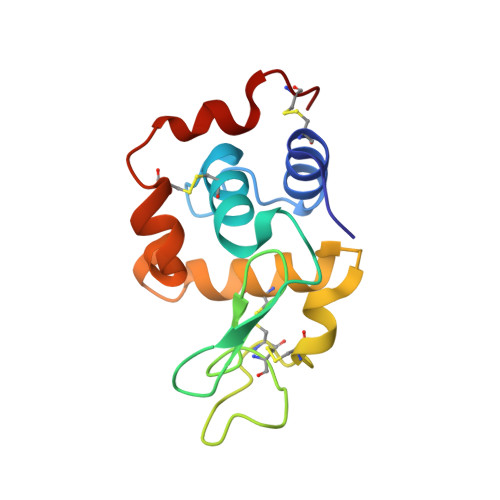The Interdependence of Wavelength, Redundancy and Dose in Sulfur Sad Experiments.
Cianci, M., Helliwell, J.R., Suzuki, A.(2008) Acta Crystallogr D Biol Crystallogr 64: 1196
- PubMed: 19018096
- DOI: https://doi.org/10.1107/S0907444908030503
- Primary Citation of Related Structures:
2W1L, 2W1M, 2W1X, 2W1Y - PubMed Abstract:
In the last decade, the popularity of sulfur SAD anomalous dispersion experiments has spread rapidly among synchrotron users as a quick and streamlined way of solving the phase problem in macromolecular crystallography. On beamline 10 at SRS (Daresbury Laboratory, UK), a versatile design has allowed test data sets to be collected at six wavelengths between 0.979 and 2.290 A in order to evaluate the importance and the interdependence of experimental variables such as the Bijvoet ratio, wavelength, resolution limit, data redundancy and absorbed X-ray dose in the sample per data set. All the samples used in the experiments were high-quality hen egg-white lysozyme crystals. X-radiation damage was found to affect disulfide bridges after the crystals had been given a total dose of 0.20 x 10(7) Gy. However, with such a total dose, it was still possible in all cases to find a strategy to collect data sets to determine the sulfur substructure and produce good-quality phases by choosing an optimum combination of wavelength, exposure time and redundancy. A |Delta(ano)|/sigma(Delta(ano)) greater than 1.5 for all resolution shells was a necessary requirement for successful sulfur SAD substructure location. Provided this is achieved, it seems possible to find an optimum compromise between wavelength, redundancy and dose to provide phasing information. The choice of the wavelength should then follow the sample composition and the diffracting properties of the crystal. For strongly diffracting crystals, wavelengths equal or shorter than 1.540 A can be selected to capture the available data (provided the Bijvoet ratio is reasonable), while a longer wavelength, to gain as high a Bijvoet ratio as possible, must be used for more weakly diffracting crystals. These results suggest that an approach to a sulfur SAD experiment based on a complete description of the crystal system and the instrument for data collection is useful.
- European Molecular Biology Laboratory, Hamburg Outstation, c/o DESY, Notkestrasse 85, D-22603 Hamburg, Germany. michele.cianci@embl-hamburg.de
Organizational Affiliation:


















